Lea Wait's Blog, page 320
May 29, 2014
Bidding Your Baby Goodbye
Hey all. Gerry Boyle here, just picking up around the study today. Notebooks, ripped sheets of paper, sticky notes, scrawled and illegible reminders, books held open with other books, wrinkled manuscript pages of my new McMorrow novel, ONCE BURNED.
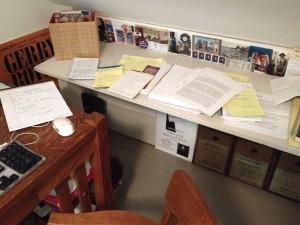
The study before
Because it’s done, more or less. Versions 1, 2, and 3 have been worked over. Editor’s questions have been answered or at least addressed. I’ve fiddled and diddled and read and reread. I’ve reworked passages, deleted others. I’ve added a postscript and even a post postscript. Now it’s time to send this one out into the wide, wide world.
This is an odd moment in the life cycle of a book. You spend a year or more with the thing, starting with the seed of an idea. The seed grows, changes, turns into a few pages of hastily scribbled notes. The notes become sketches, outlines, stacks of legal pads, bookmarked pages in reference books, transcripts of interviews. Then there are outlines, which you print out and position carefully on the desk beside the computer screen. And then you start to write.
ONCE BURNED has a whole section of folders on my hard drive. It’s had three titles. Characters have had various aliases. Some characters auditioned for the book and, sadly, didn’t get a call back. I encouraged them to try again in the future. There was much about them to like.
 In coming weeks and months it will be copyediting, cover design, marketing plans, galleys to reviewers. But today I’m in the midst of the bittersweet task of gathering up the stuff, stacking it in neat piles, taking the piles and moving them off the desk top. This one is done; on to the next.
In coming weeks and months it will be copyediting, cover design, marketing plans, galleys to reviewers. But today I’m in the midst of the bittersweet task of gathering up the stuff, stacking it in neat piles, taking the piles and moving them off the desk top. This one is done; on to the next.
It reminds me of walking through my kids’ rooms after they headed off to college. Some of their stuff was gone, and the remainder was neatened and put away and sanitized so that the rooms bore little resemblance to the place they’d lived all those years. It was time to move on.
Same way with the stuff that goes into a book. All of the things that were so useful for the last few months are suddenly irrelevant. The stacks move to the end of the work table. Then onto the floor. Then maybe out to the archives in the barn. Or just to the recycling.
It’s an interesting moment in the creative process, this house cleaning. It’s inevitable and totally expected but still, after doing it a dozen times or more, it still gives me pause. Because living with a book during the writing process is very different from seeing it realized. Huddling in the study vs. readings and signings and interviews. Two very different things.
So out with the old and in with the new. The sketches are already underway. The outlines. The small stack of stuff for the next one will grow quickly over coming months. The mess, I’m glad to say, will soon return.
May 28, 2014
Never Getting My Homework Done
Kate Flora here, on another rainy cold morning. Barely awake and already behind. Spring is my favorite season. I can spend hours just lingering in the flower beds, watching last year’s hopeful little plants springing back and owning their spaces. But not this year. Even if the weather did cooperate and we had more than a day of sun, I have too much homework.
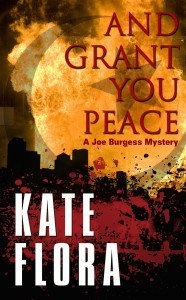 Lately, my joking motto is: I used to be a writer until I got published. Unfortunately, it feels way too true. I am backed up with all of the details of getting ready to launch two fall books. Already behind, without enough events set up, without my PR materials polished, my website redesigned, my new police-related blog posts written and tweaked. I have a book due in July and no time to finish it. I have a lecture to write for class this morning and no time to finish it. I have a manuscript to review before it can become a POD book so the whole Burgess series is available in print and e-book format. I have a writer waiting for feedback on her book. I have a date with Gator the Bedbug Dog to watch him in action. I think I’m getting a headache.
Lately, my joking motto is: I used to be a writer until I got published. Unfortunately, it feels way too true. I am backed up with all of the details of getting ready to launch two fall books. Already behind, without enough events set up, without my PR materials polished, my website redesigned, my new police-related blog posts written and tweaked. I have a book due in July and no time to finish it. I have a lecture to write for class this morning and no time to finish it. I have a manuscript to review before it can become a POD book so the whole Burgess series is available in print and e-book format. I have a writer waiting for feedback on her book. I have a date with Gator the Bedbug Dog to watch him in action. I think I’m getting a headache.
I shouldn’t complain. It is the greatest gift of my life that I get to do what I love. I just wish I had a staff to do the things I don’t love so much, so I could spend more time at the writing. More time teaching aspiring writers to trust themselves and believe in their dream. I really would like to put my winter clothes away. But I’m not sure there is going to be summer this year, so many it isn’t such a bad thing to still have my sweaters at hand.
For small bits of time, I do push away the to do list, the endless homework, the things that belong to the “business” of writing, and the business of living, like laundry and groceries, and go out to the garden.
For longer bits of time, I accept that I will never get my homework done. I push that list away and  remember that I’m a writer and do what I tell my students is so critical: writers write. I immerse myself in story and watch my character try and get herself out of the current jam she’s in. I try to imagine what the room looks like, how intense her fear is, what the bad guy’s own narrative is (because we are all the heroes of our own stories), and how I will weave and blend and hide things in plain sight and tell a story that you won’t want want to put down. I try to meet my quota of 1000 words a day.
remember that I’m a writer and do what I tell my students is so critical: writers write. I immerse myself in story and watch my character try and get herself out of the current jam she’s in. I try to imagine what the room looks like, how intense her fear is, what the bad guy’s own narrative is (because we are all the heroes of our own stories), and how I will weave and blend and hide things in plain sight and tell a story that you won’t want want to put down. I try to meet my quota of 1000 words a day.
I’ve said this here before, but it’s something I keep coming back to often. It’s a quote from Philip Gourevich, in his sad, horrifying, and powerful book about the Rwandan massacre, We Wish To Inform You That Tomorrow We Will Be Killed With Our Families. Gourevich writes: “This is what fascinates me most in existence: the peculiar necessity of imagining what is, in fact, real.”
 Whether I’m writing fiction or nonfiction, imagining it is a necessary part of the job if I am to write the kind of powerful books that will let my readers truly see the stories in their imaginations. And it can be a hard job, going around with such dark characters and images in my mind, hardest of all when the characters are real, but plenty hard when they’re only imagined. When I’ve made up the dusty, spider-filled basement or the snowstorm or the scene where the body is found. It’s also a job I embrace, because when I rise to the challenge and it works, I’ve written the book I set out to write, and hopefully, made you feel the story more deeply.
Whether I’m writing fiction or nonfiction, imagining it is a necessary part of the job if I am to write the kind of powerful books that will let my readers truly see the stories in their imaginations. And it can be a hard job, going around with such dark characters and images in my mind, hardest of all when the characters are real, but plenty hard when they’re only imagined. When I’ve made up the dusty, spider-filled basement or the snowstorm or the scene where the body is found. It’s also a job I embrace, because when I rise to the challenge and it works, I’ve written the book I set out to write, and hopefully, made you feel the story more deeply.
May 26, 2014
Downeast Doings, Part 2
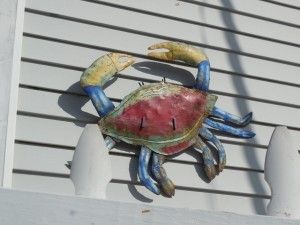
Hello from Eastport, Maine
Hello again from Sarah Graves, writing to you from Eastport, Maine where we are all working as fast as we can to get things accomplished before the snow gets too deep again. We just had two bright, sunny days, here, and everyone is exhausted: digging, hammering, painting, mowing, raking…and oh yeah, getting those snow shovels put away. Until now we’ve all felt too superstitious to take them off the front porch. Now it’s raining a little and we are glad to be able to put our feet up for a minute.

…I hear you knockin’ but you can’t come in…
Speaking of which, I am writing this from my new recliner. Not my usual writing spot and it won’t be, either; my regular location, up in my office, is part of the unvarying routine that helps me to drop into the writing process as smoothly as possible. Still, I hit mental obstacles as often as the next person, feeling as if there’s no way in, all windows and doors boarded up against me. And when I do I try to remember these lines from Richard Wilbur’s poem, Walking to Sleep: “As a queen sits down, knowing that a chair will be there, Or a general raises his hand and is given the field glasses, Step off assuredly into the blank of your mind. Something will come to you.” Watch out, though. Later in the poem, Wilbur suggests that what comes may not be entirely benign, and that it depends on…well, I won’t give it away.
One bit of news that I’m really very pleased to share: all fifteen books in the Home Repair is Homicide series, set right here in Eastport and starring amateur old-house fixer-upper Jake Tiptree, will soon appear as e-books from UK publisher Hodder & Stoughton. I don’t know what else to say about this, I’m still kind of walking around dazedly about it, but I can tell you that if you were to alert friends, relatives, and strangers on the street in the UK about the imminent availability of Jake & Co. e-books, I wouldn’t object in the slightest.
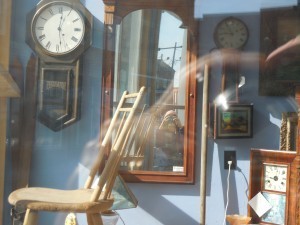 The windows in downtown Eastport continue to fascinate me. This one is a short story, or maybe even a novel, waiting to be written. When I finish a novel I usually have a burst of writing energy, like an engine backfiring right after you’ve shut it down, that gets me through another, shorter project. So fairly soon, with any luck, I’ll have both the time and the inclination. But I usually use the “walking to sleep” method to generate short stories, so the window will likely go unwritten — unless you’d like to use it?
The windows in downtown Eastport continue to fascinate me. This one is a short story, or maybe even a novel, waiting to be written. When I finish a novel I usually have a burst of writing energy, like an engine backfiring right after you’ve shut it down, that gets me through another, shorter project. So fairly soon, with any luck, I’ll have both the time and the inclination. But I usually use the “walking to sleep” method to generate short stories, so the window will likely go unwritten — unless you’d like to use it?
Finally, a request for help from the driving-me-crazy department. Which is by the way a very large department, and people seem to be building new rooms onto it all the time, but never mind: Do you know who said, “The theater is a device for making people think that they are feeling and feel that they are thinking.” ? If you do, could you please solve this mystery for me by replying here? And if possible give a citation for it. Thanks in advance!
Meanwhile I’m going to test this recliner a little more to make sure it’s all right. Because, you know, I wouldn’t want someone else to get hurt on it when I could’ve just…zzzzz.
May 25, 2014
I Get By With A Little Help From My Friends
John Clark here:
I’ve had several comments from blog readers saying they like learning about the Maine library community and some of the people who make it function so well. I don’t know if you have seen any of the recent articles, particularly in The Bangor Daily News about the extremely difficult times some small Maine libraries are facing. My friend and fellow librarian, Cara Sawyer, at the Cherryfield Library is really worried about the increasing cost of operations at a time when endowment money and municipal support are getting shakier every year. In Millinocket, there was talk this spring about closing the library completely because of the huge hit the tax base is taking because of the last paper machine being sold. That has been forestalled for the moment, but everyone associated with that library is concerned.
There are many other small libraries in rural areas run by dedicated people, many of them self taught, who never had an opportunity to attend library school. A lot of them make minimum wage, have a work week of less than 30 hours (but probably work 5-10 more hours every week than they’re paid) and get little or no benefits. There are even small libraries that have no bathroom. In sum, you really need to love what you do to run a small Maine library.
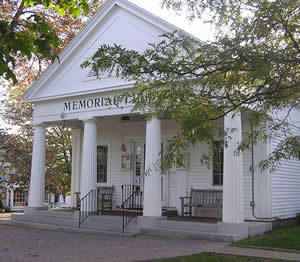
The front of the Boothbay Harbor Memorial Library
I’ve run two in my time, The Boothbay Harbor Memorial Library and the Harrtland Public Library. In Boothbay Harbor, there were three of us, me, Mary Pinkham and Linda Barter. For six or seven months every year, we handled our regulars as well as an influx of summer residents and vacationers that often swelled the population by a factor of three or four. The thing that kept us sane was the cadre of wonderful volunteers who helped in two or three hour slots all week. We had shelf readers, circulation folks, book menders, people who staffed the Friends bookstore next door and our fabulous Friday morning Thank-you ladies who wrote notes for every donation we received and then headed off for lunch together. I was required to stop at the table where they worked and tell one joke every week. It was something I really looked forward to.
Five years after leaving Boothbay Harbor to work at the Maine State Library, I returned to the role of running a small public library here in Hartland. While the mechanics of running any public library aren’t dissimilar, the locale, the social/political geography and the patron base all combine to create a unique work environment. Hartland was markedly different from Boothbay Harbor. It was poorer, smaller, inland and in a far more conservative part of Maine. However, people who use libraries are generally outgoing and I’m firmly convinced there’s no better way to fit into and understand a community than being the town librarian. When I started in Hartland, the library wasn’t particularly busy. That began to change and with it, the need for help with all aspects of the operation. Like Boothbay Harbor, this library couldn’t function without volunteers. Unlike Boothbay Harbor, my volunteers are generally younger and work for the entire day.
There are still libraries in Maine where there’s an invisible line between what staff and volunteers can do. A long time ago, I worked for a man I disliked intensely, but he taught me one extremely valuable lesson. We’re all penciled in. He was right and I try to keep that in mind when I add a new volunteer. The more they know how to do, the easier my job becomes and the better the library operates, so I teach them everything they’re willing to learn.
Right now, I’m blessed with having three very capable young women volunteering with me at the library. They have different backgrounds and personalities, but share some extremely important character traits. They’re all quick learners, they have good customer service skills and they enjoy working at the library.
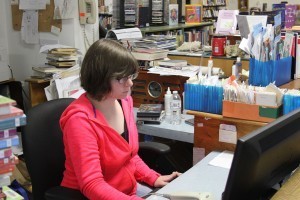
Deana working on finding DVDs that need to be moved to storage
Deana Morgan has been with me for at least four years. She and her mother, Savilla were active volunteers when I came here eight years ago, helping to decorate and put on our summer reading program. When Deana expressed an interest in volunteering, we set Friday as her day. If I were to describe her in two words, they would be quiet competence. Deana doesn’t say much, but is incredibly efficient. Whenever I ask her to tackle a project, I do so knowing that she will get it done quickly, get it done correctly and do it while handling the circulation desk and the interlibrary loans. She’s one of the sharpest people I know and she and her mother are amazing bargain hunters. They’re an integral part of the annual Fireman’s Auxiliary Christmas program and have been able to find endless bargains to help the cash donated to this great effort go far year after year. Deana is also incredibly computer literate and frequently helps patrons find things online when they’re lost. She also covers the library when I am on vacation or at a conference. Even better, she and Savilla took on the task of snow removal last winter and did a stellar job. She also has a sideline selling worms and nightcrawlers to local fishermen.
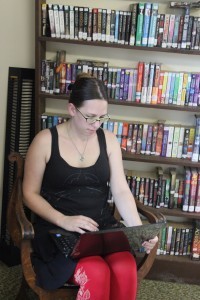
Brianna working on one of her assignments for library school.
Brianna Wilshusen volunteers on Thursday. She and I have known each other since she was in junior high and I’ve watched her make lemonade numerous times when life handed her lemons. She dropped out of high school and struggled with family issues without getting the sort of support teens need to be successful. After a few tough years, she found herself a single mother of two, Alex and Pheobe, living in a rural rental and not having a drivers license or a car. Plenty of people in that situation have thrown in the towel. Brianna did not. Instead, she’s worked with the ASPIRE program and is now enrolled in the library science program at the University of Maine, Augusta. She’s holding a B- average while being a terrific mother to her kids, reading to them every night. She would be the first to tell you that one of the biggest disadvantages of being a 21 year old single mom of two is the difficulty in finding or reconnecting with friends. Those her age who are single are into a completely different and less mature lifestyle. However, she’s really enjoying the satisfaction that comes with achieving a goal like getting into college when it seemed like it was slipping away not so long ago.
Brianna is outgoing and funny, characteristics that make her popular with patrons. She’s discovered one of the secret downfalls of working in a library that has extensive science fiction and young adult collections. Every week, she finds another half dozen books she really wants to read. She’s also become one of our reviewers of new childrens and young adult books we get as part of the Central Maine Library District’s “Five For Five” Program.
My most recent volunteer addition, Sarah Nadeau, has been with me for the past three months. She works four days a week, overlapping on Thursdays with Brianna. Sarah fell at work last December, tearing a ligament in her left wrist and came to the library as part of her rehabilitation under the worker’s compensation program. She’s also funny and outgoing, although a tad quieter than Brianna, and has very good telephone and customer service skills. However, there are times on Thursdays when the three of us feed off each other and patrons must wonder if they’re in a library or a lunatic asylum. It’s great stress therapy for me.

Sarah working the circulation desk.
Sarah picked up things quickly and has the daily routine down quite nicely. Like Brianna, she’s discovered just how many books have a fatal attraction and insist upon going home with her at night. One area where she has helped the library is in getting people her age who had never come to the library come and see what we have. We’ve picked up half a dozen patrons thanks to her telling them what we have to offer.
I’ve gotten quite an education into what a train wreck the Maine worker’s compensation system is thanks to Sarah. She’s very determined to get better and get a full time job, but has to deal with someone in another state who doesn’t bother to return phone calls and refused to approve payment for a prescription for an anti-inflammatory medication prescribed by the physician treating her injury. After watching this debacle unfold, I understand why young people want to go somewhere outside Maine to work and live.
Thanks to these three ladies, the library is able to function smoothly and handle seven times the daily circulation it had when I first assumed my position. One of the negatives of having such an increase is the feeling that you’re falling behind a little more every day. With their capable help, I’m going in the opposite direction and it’s really nice to leave work knowing things are more organized and another project got completed.
May 23, 2014
Weekend Update: May 24-25, 2014
 Next week at Maine Crime Writers there will be posts by John Clark (Monday), Sarah Graves (Tuesday), Kate Flora (Wednesday), Gerry Boyle (Thursday), and Kaitlyn Dunnett/Kathy Lynn Emerson (Friday).
Next week at Maine Crime Writers there will be posts by John Clark (Monday), Sarah Graves (Tuesday), Kate Flora (Wednesday), Gerry Boyle (Thursday), and Kaitlyn Dunnett/Kathy Lynn Emerson (Friday).
In the news department, here’s what’s happening with some of us who blog regularly at Maine Crime Writers:
Maine Crime Writers (two current and one alum) took the three spots as finalists for the Maine Literary Awards for Crime Fiction:
Paul Doiron for Massacre Pond
Al Lamanda for Sunrise
Barbara Ross for Clammed Up
The winner will be announced May 29. Kate Flora took top honors last year for Redemption. For a complete list of 2014 nominees in all categories look here.
Meanwhile, Maine continues its outsized role in recognitions in the mystery world in 2014. The nominees for the Anthony Award given at US mystery’s largest convention, Bouchercon, were announced this week. MCW alum Julia Spencer-Fleming is nominated for Best Novel for Though the Evil Days and Friend of the Blog, Chris F. Holm is nominated for Best Paperback Original for The Big Reap. Also in that category, unknown Mainer Stephen King for Joyland. For a full list of nominees, look here. Winners will be announced in November.
John Clark has a short story appearing in the May 31st issue of King’s River Life. http://kingsriverlife.com/
An invitation to readers of this blog: Do you have news relating to Maine, Crime, or Writing? We’d love to hear from you. Just comment below to share.
And a reminder: If your library, school, or organization is looking for a speaker, we are often availble to talk about the writing process, research, where we get our ideas, and other mysteries of the business. Contact Kate Flora: kateflora@gmail.com
May 22, 2014
How I Quit Being a Crybaby and Learned to LOVE Editing
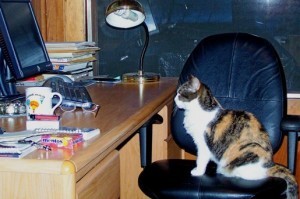 Al Lamanda: Okay, maybe not love editing, but at the very least develop a healthy respect for it. After all, who doesn’t want to see their work made as perfect as possible before unveiling it to the masses. Or an agent. Or a publisher. Or in my case, my harshest critic, my spouse.
Al Lamanda: Okay, maybe not love editing, but at the very least develop a healthy respect for it. After all, who doesn’t want to see their work made as perfect as possible before unveiling it to the masses. Or an agent. Or a publisher. Or in my case, my harshest critic, my spouse.
Years ago, I learned a valuable lesson when a manuscript I sent to an agent was mailed back to me (yes, we actually did go to the Post Office in those days) with just three words handwritten on a post-it-note. EDIT. EDIT.EDIT.
My initial response was (Stop me if you’ve heard this one before) anger. How could someone care more about a few typos than the content of the words? How could someone care more about a few misplaced commas and misspelled words than the story, plot and characters? The words are what matter and not a misplaced comma, apostrophe, (apostrophe never looks spelled correctly by the way) or typo. After a few more (okay, a lot more) post-it-notes from agents, the message began to sink in. No one is going to read your work if the work you’re submitting is an unedited mess. Why should an agent or publisher care about your work if you don’t care enough to send them a polished draft?
My lovely spouse suggested I get someone else besides our cat to check over my work, or learn some editing tips so my work is a bit more polished when I submit it. I took the advice to heart and instructed my cat to do better. No, not really. What I did do was scour the earth for anything I could find on editing. And by scour I mean, use of the internet for articles, advice, recommendations and then a good old fashioned trip to the library and my local bookstore. After much reading, research and trial and error I learned that editing seems to always come down to four basic steps. Most writers do these four steps or some of them without being aware of them. It just seems to make sense to polish your work as much as possible before sending it out to someone who might reply with a post-it-note.
So, this is what I do, and you probably do one or all of the same. (Swear words are optional.)
Step One. When I sit down to write, before I write one new word, I read what I wrote the day before. I revise, edit and make changes before writing anything new. This will become the first draft of your book. (The post-it-note draft)
Step Two. When your first draft is complete, go back to word one on your computer and revise and edit the entire manuscript. This becomes the second draft.
Step Three. The hand edit. Print a copy of the second draft. Beginning with the first word to the last, you read and make notes in margins and on pages of mistakes, changes, deletions and additions. Then, using your hand edit notes, go back into your computer and make the changes. This is now your third draft.
Step Four. Print a hard copy of the third draft. Now read it. I read out loud. (My cat is a good listener) It may take me several days to do this, but it’s worth it. I make notes on phrases and sentences that sound hollow or false, where something causes me to stumble or doesn’t make sense. (If something doesn’t make sense to me, imagine how the reader feels) I make notes and changes right on the pages. When I am done, I go back to my computer and update the third draft with these changes. (This is usually the swear words part of the process) I am now pretty sick on my own book, but the fourth draft is polished and ready to be seen by agents and publishers. When an agent or publisher requests my manuscript by email, I am fully confident that if it is rejected it won’t be on a post-it-note.
Is this process a tedious pain in the butt? Yes, it is. Is it worth it in the long run? Yes, it is. Because after four edits, your book will be ready.
On the other hand, I could just let you borrow my cat. She works for treats.
May 21, 2014
Opening Up by Barbara Ross
Hi all. Barb here. I am in Book Jail. Book Jail is the place where writers must go when they have an imminent deadline (mine is June 1) and they have been bad, procrastinaty writers and are behind. Book Jail is a terrible place, where the writer is forced to feel sorry for herself and ask whiny questions like, “Why can everbody go out to dinner except me?” “Why can everybody go to the movies except me?” and, increasingly, as the weather improves, “Why is everybody outside except me?”
So, long story short, I’m rerunning a blog post past about the many rituals of opening up our Maine house every year. Enjoy.
For me, one of the joys that comes with seasonal home ownership is opening the house in the spring and then closing it again in the late fall. These mirror-image rituals mark the passage of the seasons and I find great comfort in their familiarity.
 The Plumber: A few weeks before we plan to return, our first call is to Bill, our plumber. “This is Bill the plumber,” his answering machine says. “I’m not taking any new customers.” This has been Bill’s standard greeting for as long as anyone can remember. Non-New Englanders might find it a little abrupt or discouraging. Or, they might think it crazy to turn down potentially lucrative new business before you’ve even heard what it is. But this is just the Maine way. Take as much work as you can do well, leave the rest for others, and don’t pussyfoot around about it.
The Plumber: A few weeks before we plan to return, our first call is to Bill, our plumber. “This is Bill the plumber,” his answering machine says. “I’m not taking any new customers.” This has been Bill’s standard greeting for as long as anyone can remember. Non-New Englanders might find it a little abrupt or discouraging. Or, they might think it crazy to turn down potentially lucrative new business before you’ve even heard what it is. But this is just the Maine way. Take as much work as you can do well, leave the rest for others, and don’t pussyfoot around about it.
Fortunately, we are not new customers. In fact, Bill is the only person on the planet who knows his way around our ancient plumbing system, so I forge on. I tell him the date we plan to come up and ask him to coordinate with the town to get our water back on. The first indication I’ll get that the work has been done will be a bill from the town followed, a couple of weeks later, by an invoice from Bill. During this entire exchange we will never have spoken. It’s not that we don’t know Bill. Over the summer something is bound to require his attention (see ancient plumbing above), but our opening up ritual requires no live conversation between us.
The Cable Company: The next call is to the company that supplies our TV/internet/phones asking that we be taken off suspend and service restored. To accomplish this, I must imitate an 80+ year-old woman and keep my mother-in-law’s social security number at the ready so I can prove I am actually her. When we bought the house from my mother-in-law, we naturally took over payment of the utilities. Things went along fine when our cable was supplied by Adelphia, but then Time Warner bought them and had grave, grave misgivings about my husband or me making changes to the service.
“But we pay the bills,” my husband objected. “Oh, we let anyone pay the bills,” the customer service lady cheerfully responded. “You just can’t change the service.” Our choices, she told us, were to pay stiff fees both to close down my mother-in-law’s service and to initiate our own (despite the fact that no one at the cable company would have to leave their offices to accomplish this) or to drive to Rockland or Augusta, each more than an hour away, and present our drivers’ licenses to prove who we are. She never could explain how proving who we are would allow them switch the service away from my mother-in-law, so wary of a long drive with no results, we instead resort to subterfuge. I suspect I sound more like someone in a Monty Python skit than an actual eighty-year-old, but whatever makes Time Warner comfortable.
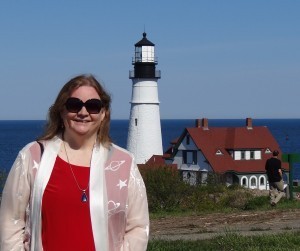
Me at the wedding
Three Inspections: So all is ready and we’re actually coming up. This year we attended a beautiful wedding in Portland on Saturday and stayed overnight at the home of fellow Maine Crime Writer Lea Wait and her husband Bob on Sunday. We talked for hours about writing, art, politics, old houses and Maine. It was such a great time. Then on Monday, we jumped into our car, drove to our house and began our ritual three inspections. The House, The Garden and The Town: What survived and what did not over the winter? Honestly, we are as disappointed when a favorite breakfast place doesn’t make it through winter as we are when we find our back steps didn’t, either.
Settling In: Putting out the porch furniture, stocking the refrigerator and cupboards, opening the shades, airing out the rooms.
Meeting with Stan: After we list the repairs needed, we meet with “our guy.” This is the guy every seasonal resident needs to hook them up with all the other guys in the area who fix stuff. Our guy happens to be a Stan. We know he’ll tell everyone we’re helpless as kittens but we don’t interfere too much and pay on time, so that’s fine with us. Stan has a list of his own of things we must do, and painting is always on it. Owning a wooden house by the water is a bit like owning the Golden Gate Bridge. Some part of it is always being painted. This year we’re lucky, it’s just the porch steps.
Living Life: Writing in the alcove with a view of the harbor, barbecuing dinner, waiting for our son and daughter-in-law to arrive for the long weekend.
It’s great to be back.

The view as I’m typing this post.
From Ox to Smack
James Hayman: Anyone who’s read my third McCabe/Savage thriller, Darkness First, knows the story opens with a bad guy named Conor Riordan smuggling 40,000 80mg oxycontin tablets stolen from a Canadian pharmaceutical distribution center in Saint John, New Brunswick back into Eastport, Maine. In the book, these tablets have a street value in Maine of nearly five million dollars. They also are ultimately responsible for the murders of nine mostly not so innocent people.
The idea for Darkness First was initially triggered by a newspaper article I read about prescription drug abuse in Maine and most particularly in poor rural areas like Washington County.
To research the book, I spent a day talking with Sheriff Donnie Smith of Washington County. In our discussion Sheriff Smith estimated that, at that time, nearly half the teenagers and young adults in Washington County were addicted to “ox.” I was stunned by the number and asked where all these pills came from. He told me most were bought and sold in small quantities, some initially stolen from pharmacies, others sold by people who had legitimate prescriptions they hadn’t finished, still others purchased by “doctor shopping”, which means getting multiple prescriptions for pain relief needs from a number of different doctors.
When I pressed for more information, Smith referred me to his liaison with the Maine Drug Enforcement Agency. In discussions with this agent, I learned that the usable supply of “Ox” in Maine was dwindling and that, as a result, prices were going up. The tightening of supply was due, in part, to more energetic enforcement policies and stricter limits on the number of tablets doctors were allowed to prescribe.
It was also due to changes in the manufacturing process. To fight abuse of its product, Purdue Pharma, the number one American manufacturer, had developed a harder time-release coating that made it much more difficult, if not impossible, for addicts to crush and snort the tabs for an instant high. Melting for use in hypodermics was also more difficult. Due to the more limited supply, street price (at the time I talked to him) had risen to $120 for an 80 mg tablet. Far more than most addicts could afford.
I asked if such high prices might not tempt professional drug dealers to import tablets from somewhere else. He agreed that this was indeed possible. He suggested one likely source might be Canada since Canadian manufacturers had yet to adopt Purdue’s new process. In his mind, a worst-case scenario was the one I used in the book, the large-scale theft and smuggling of Canadian 80’s by boat into Eastport.
Unfortunately, the real worst-case scenario turned out to be heroin. Confronted with stricter enforcement policies and sky-high street prices, oxycontin addicts in Maine and elsewhere in New England simply turned to a cheaper and more plentiful alternative.
Over the last three years the supply and use of heroin in Maine and other Northern New England states has skyrocketed. Dr. Mark Publicker, an addiction specialist in Portland, was quoted in a Bangor Daily News article as saying “We had a bad epidemic (before), and now we have a worse epidemic. I’m treating 21-, 22-year-old pregnant women with intravenous heroin addiction. It’s easier to get heroin in some of these places (in Maine) than it is to get a UPS delivery.”
Most of the heroin used in Maine is grown and processed in Colombia and then crosses the border through Mexico. From there substantial quantities flow up through New York to Lowell or Lawrence, Massachusetts and from there on into Maine. Instead of $120 for a single oxycontin tablet, a gram of heroin might cost $45 in Lowell or Lawrence and a single dose $5. An addict can cover his own heroin needs and make a profit selling to others by making the drive. Small time dealers from Maine can find even cheaper prices in Boston and New York.
According to an article by Katharine Q. Seelye in the New York Times, “a $6 bag of heroin in New York City fetches $10 in southern New England but up to $30 or $40 in northern New England. The dealer gets a tremendous profit margin, while the addict pays half of what he might have to shell out for (oxycontin)…”
Today, heroin is not only cheaper and more readily available than oxycontin, the high is stronger. And smack, as its called, is also more addictive. New users who start by injecting small amounts find they quickly need larger and larger doses to get the same high and satisfy the craving.
All too often the results of heroin addiction can be tragic. Heroin killed 21 people in Maine last year, three times as many as in 2011. Sadly, those numbers are likely to rise further.
Katharine Seelye’s piece in the Times describes one case. She writes: “Theresa Dumond, 23, who lives on the streets of Portland, said she sells her body three times a day to support her heroin habit. She lost custody of her two young children about a year ago (“I can’t keep track”), and their father died.
“I’ve lost everything,” she said as she and a companion, Jason Lemay, 26, walked to an abandoned train tunnel, littered with old needles and trash, to shoot up. “The heroin numbs the pain and makes you not care about life,” she said.
Her only concern now is scoring more heroin. She pays no attention to food and sleeps where she is or in a shelter.”
May 19, 2014
MAY FAVORITES
Susan Vaughan here. Last fall I wrote about my October favorites, so I thought I’d indulge in something similar. My dog Sasha insists on taking me for walks along our lane and on the woods path, showing me all the new growth and returning birds. So here are my faves, as we stroll along…
Dogtooth violets carpet the woods more than usual this May. Before other low-growing plants take over, they’re a bright yellow (not violet) reminder the sun is in the sky for longer each day. I nearly tripped a few times admiring the expanse of color.
Purple trilliums dot the woods floor here and there among the dogtooth violets and in one spot have taken over. The flower is also called wake-robin and stinking Benjamin, not a flattering name for a pretty blossom, but up close you can’t miss the nasty scent.
Our woods are home to a pair of barred owls. This morning the two of them perched silently in adjacent trees along the lane, apparently blasé about the crows flapping around and complaining about their presence. I can’t wait to see the owlets, decked out in fluffy feathers and learning to hunt frogs in the small pond. Sasha, of course, paid no attention to the activity in the trees. She was as usual nose to the ground.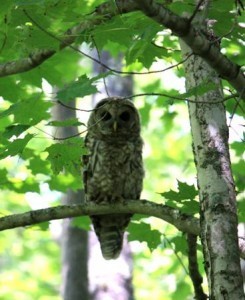
Many songbirds have returned north to our feeder to join the chickadees and nuthatches—goldfinches, house finches, and others I’d need to study a bird book to name. But the king—or queen—of the woods is a woodpecker. I laugh along whenever I hear the loud ha-ha-ha-ha-ha echo through the trees. The pileated woodpecker is the largest North American woodpecker, about crow size, but its red crest and long tail feathers make it appear larger. It was the model for Woody the Woodpecker.
Lastly, seeing my own shrubs and flowers bloom cheers me, especially after such a long, cold winter.That was it for this walk. Ready for a biscuit and a nap, Sasha led the way to the door.
*** My newest releases are the Task Force Eagle trilogy and Primal Obsession. You can find excerpts and buy links at www.susanvaughan.com.
May 18, 2014
Once Upon a Time … in Maine
Today our guest at Maine Crime Writers is Jenny Milchman, whose newest book, RUIN FALLS, was published in April. Welcome, Jenny!
I spent a lot of time in Maine, summers as a child. Monhegan Island, Port Clyde, Cushing, Rockport…

Jenny Milchman
all of these places forged me in deep and abiding ways. But I’ve spent even more time in pages about Maine, and by Maine writers. There’s a fictional town that feels realer to me than, say, Presque Isle or Greenville. I feel I know authors from their books better than any of the friendly but rather buttoned up Mainers who handed me my mail or served meals at diners when I breakfasted there on vacation.
The first time I traveled to Maine via a novel, I went to a little town called Castle Rock. “Not so long ago,” Stephen King writes in Cujo, “a monster came to the small town of Castle Rock…”
I read this book when I was probably too young for it—amidst tears and battles with my parents who were not horror fans themselves and didn’t quite know what to make of the fact that I never had nightmares—and was instantly transported. Not to a horrific story, although it was that, of course, but to a town that became a sort of second home to me. A place where everyone knew each other, and where there was a meta existence for rabid (excuse the pun) fans. By reading every one of Stephen King’s books, I was let in on all sorts of inside facts and references to Castle Rock. I knew the waitress whose story was told in The Dead Zone. Those kids in It introduced me to a new town that would go on to echo in books to come. Stephen King provided a sense of belonging for a little girl who felt like she didn’t belong.
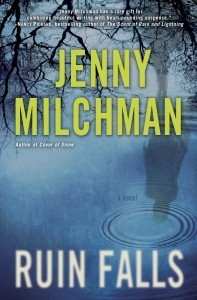 Another Maine writer played a different, but no less important, role in my life. You see, that little girl who fit better into a fictional town than her real one, grew up to want to be a writer herself. And my road to publication was as twisted as anything in a book. It took me thirteen years to finally land a book deal, in part because while I had always read suspense, I’d never tried to write it until I got to work on my first novel. At that point I began to read every thriller I could get my hands on, including the tales of medical mayhem that Tess Gerritsen penned.
Another Maine writer played a different, but no less important, role in my life. You see, that little girl who fit better into a fictional town than her real one, grew up to want to be a writer herself. And my road to publication was as twisted as anything in a book. It took me thirteen years to finally land a book deal, in part because while I had always read suspense, I’d never tried to write it until I got to work on my first novel. At that point I began to read every thriller I could get my hands on, including the tales of medical mayhem that Tess Gerritsen penned.
I wrote Tess a fan letter at a certain point, and mentioned—as aspiring writers are wont to do—that I was working on a novel myself. Tess was kind enough not only to write back, but to share the name of her agent. Although it would be years before I was ready for an agent to take me on, I have never forgotten how a real author made me feel just a little bit real myself. She gave me a whole different sense of belonging.
Once I finally broke through, another Maine author offered welcome. Julia Spencer-Fleming brings the region she writes about so vividly to life that she inspires me in my own work. And when I finally had a book out, not only was Julia good enough to offer me a blurb, she even spoke beside me at one of Maine’s great bookstores, Longfellow’s in Portland. Julia’s husband has become a friend in the book world as well—another part of my Maine family. And since Julia appears right here on this blog, I feel like this post has come full circle.
Stephen King says that reading a book closes a circle between author and reader. My circle opened right here in Maine.
Jenny Milchman’s debut novel, Cover of Snow, was chosen as an IndieNext and Target Pick, won the Mary Higgins Clark award, and is nominated for a Barry. Jenny’s second novel, Ruin Falls, came out in April and she hit the road with her family on the second of her multi-month book tours, which will hopefully bring her to Maine.
Lea Wait's Blog
- Lea Wait's profile
- 509 followers





